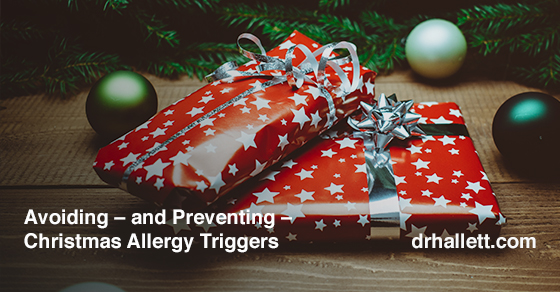
For allergy sufferers, the Christmas season can mean more than admiring decorations, opening presents and enjoying family. Sneezes, runny noses and watery eyes can drop in uninvited, because during the holidays, allergy triggers are everywhere. Avoidance, as always, is key; but so too is prevention.
Get your medications on board
Before you pull those boxes of decorations out of the attic, remember what else you’re getting: all the dust that’s settled on them since you put them away last January. So make step one taking your oral antihistamines and nasal steroids before you put on those work gloves. Also, consider wearing a NOISH N95 mask. Wipe the boxes down with a cloth before you open them. And remind yourself to replace those cardboard boxes with the airtight plastic containers that are part of every after-Christmas sale. Those do a better job of protecting your fragile ornaments and Christmas lights from harm as well as from the mold that thrives in the dark and damp of an attic.
Treat your tree before you trim it
No one deliberately exposes themselves to allergy triggers, but every year we haul one through the front door and set it up in the middle of the living room. Measurements taken in a house in Connecticut found that mold counts rose to five times normal levels in the two weeks after a Christmas tree was brought inside.
What’s the cause? Well, to keep it green and attractive, your beautiful Christmas fir was very likely kept in a humid environment that invited mold spore growth. And no doubt there was pollen on the tree before it was cut. Even the tree sap contains substances that can irritate the eyes and mucous membranes.
To avoid contact with the sap, it’s a good idea to wear gloves (and long sleeves) when handling the tree. Give the tree a good shake and a blast from a garden hose to remove pollen and mold. You can even spray it with a garden-store fungicide. A few days spent on the patio or porch helps too; as does limiting the time the tree is in the house. Those still having issues may want to try running an air cleaner in the room where the tree is. And if all else fails, hit that after-Christmas sale for an artificial tree.
Food, pets and stress are also among allergy triggers
While the Christmas tree is a common allergy trigger, it is far from the only one we unwrap during the holidays. Among the others are:
Food. We’re tempted to eat things we shouldn’t or we eat them without thinking. Be on the lookout for those foods that can cause you and/or your guests problems, such as milk, eggs, fish, nuts and glutens.
Pets. Sure Roxy the cat and Hudson the dog are sweet, but with the colder weather they are inside for more of the day. That means more of the dander that causes allergic reactions. So wash your hands – and face – even more often than normal and try to keep Roxy and Hudson off the furniture and out of the bedrooms.
Dust mites. Damp air is a magnet for dust mites, as are guest beds and hotel rooms. Consider packing an allergy-free pillow cover.
Stress. Anxiety and other high emotions can weaken the immune systems on which we depend to fend off allergy symptoms. So take it easy. Your Uncle Mike’s really not such a bad guy.
Prevention starts with testing
If medications and avoidance don’t keep your Christmas allergy symptoms under control, then it’s time to call your allergist. Allergy triggers can’t be controlled until they have been identified. Skin testing will reveal the existence of specific allergic antibodies through exposure to various allergens. Testing is done in the office and results are available during the same appointment. Armed with the test results, doctor and patient can then develop an individualized immunotherapy program. Patents can choose either allergy injections, which must be administered under medical supervision, or allergy drops, which can be administered at home.
So start now and make sure your allergies don’t take the fun out of your Christmas holiday.